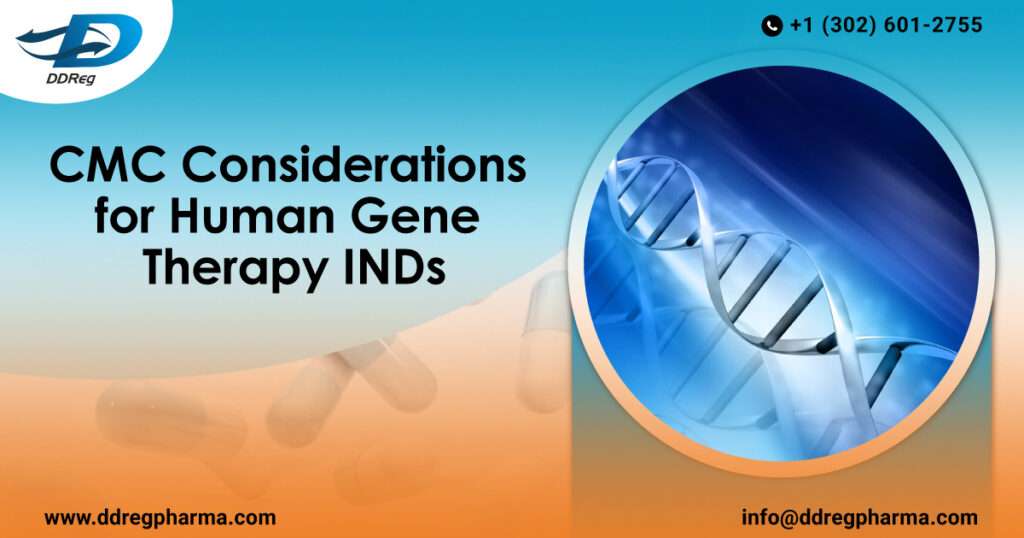Human gene therapy represents a groundbreaking frontier in medicinal products for treating complex diseases. This therapy aims to transform gene expressions or modify cellular properties for therapeutic purposes. Regulatory agencies support this innovation by ensuring the required guidelines are in place. For example, the US FDA stands as a guiding beacon for sponsors that wish to venture into Investigational New Drug Applications (INDs) of human gene therapies. With a focus on CMC information, the US FDA’s guidance document on “Chemistry, Manufacturing, and Control (CMC) Information for Human Gene Therapy Investigational New Drug Applications (INDs)” provides key information to sponsors and help them ensure safety, purity, potency, strength, and identity of the product.
Sponsors must provide comprehensive CMC information for both the drug substance and product, and manufacturing changes should be submitted for FDA review. Electronic submission of certain applications in the CTD format is now required, with exceptions for non-commercial products and specific devices. Sponsors should adapt their CMC submissions based on the phase of investigation and clinical scope, emphasizing product safety and manufacturing controls.
Detailed recommendations for CMC information submission are provided within the CTD’s Module 3, with additional guidance for administrative and quality summaries in Modules 1 and 2, respectively.
Module 1 – Administrative Information
Module 1 organizes administrative information of the CTD submissions administrative documents, including application forms like Form FDA 1571, cover letters, and reviewer guides. It’s advised that cover letters accompany submissions with a brief explanation of their content, especially for amendments detailing manufacturing changes. For significant changes, a “Reviewer’s Guide” or a document tracking changes is recommended. Labels for the investigational product must be included in the IND, bearing specific cautionary statements as per FDA regulations. Environmental analysis or a claim for categorical exclusion should also be included in Module 1.
Most INDs are eligible for categorical exclusion under certain circumstances. Previously submitted information can be referenced in the IND, either by resubmitting or through cross-referencing. Proper authorization, such as a Letter of Authorization (LOA), is required for cross-referencing information submitted by another individual. LOAs and cross-referenced files should be listed in the IND cover sheet, and inadequate cross-referenced information may lead to a hold on the IND.
Module 2 – Summary of Quality Information
Module 2 of the CTD contains the Quality Information section of the IND and it introduces the quality information available for the gene therapy product. Inclusion of a general introduction to the product with a brief explanation about its active ingredient(s), mode of action and suggested clinical use would be vital here. It should emphasize manufacturing processes, quality control and components’ qualifications and starting materials that have been employed.
Moreover, one has to recognize possible Critical Quality Attributes (CQAs) concerning product safety and activity, noting that these may change with time due to increased knowledge about them. For multi-component products such combining products, every component is described separately.
The specifics on handling the product at the clinical site including shipping procedures, storage requirements and administration should be provided. Stability data for both drug substance (DS) and drug product (DP) along with recommended storage conditions would be needed. This summary information enables reviewers to evaluate the product’s quality and any attendant risks.
Module 3 – Manufacturing Process and Control Information
Module 3 of the draft guidance provides comprehensive recommendations, focusing primarily on, which covers crucial details for both the Drug Substance (DS) and the Drug Product (DP).
Regarding DS, submissions are expected to include general information together with nomenclature, molecular structure and cellular components incorporating vector details. Moreover, it should describe manufacturing processes; controls; materials used; critical steps and validation procedures. The characterization of DS calls for description of its structure, impurities identification and analytical methods specification. Similarly, stability information and container closure system descriptions must be provided. In relation to DP, submissions should present the product description along with its composition together with pharmaceutical development studies. Furthermore, manufacturing details also fall within this section while control of excipients, analytical methods and stability assessments are other crucial parts of DP submission.
Conclusion
Sponsors must provide extensive CMC data, tailor their submissions for a particular phase of investigation and clinical coverage and meet specific requirements specified in the CTD Modules 1, 2, and 3. The advisory highlight the FDA’s dedication to promoting gene therapy products’ development while keeping patients’ safety as a priority.
DDReg has supported its customers with end-to-end CMC regulatory services to facilitate and expedite approvals for a variety of therapies in the US market. Indeed, the US FDA is among the most stringent regulatory agencies showcasing strict regulations. Read more from DDReg’s expertise: Model-integrated evidence program for generic drugs

